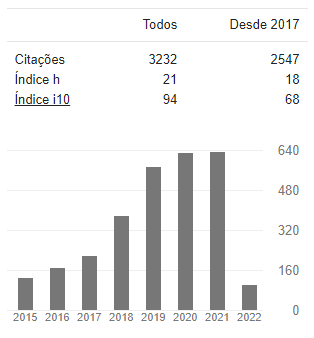THERMO-ENERGETIC PERFORMANCE OF INSULATED CONCRETE FORMS: IMPROVEMENTS IN LOW-INCOME HOUSES IN THE CLIMATE OF SÃO PAULO
Palavras-chave:
Construction materials and components, Energy efficiency in buildings, Expanded polystyrene, ICF system, RTQ-RResumo
Insulated concrete form (ICF) is an evolving construction system that could offer desired advantages in civil construction. The purpose of this study was to evaluate the thermo-energetic behavior of the ICF for use in low-income housing under climate conditions of São Paulo city – Brazilian bioclimatic zone 3. By using the Brazilian Technical Regulation of Quality for the Energy Efficiency Level of Residential Buildings (RTQ-R), the performance of the envelope of a single-family dwelling was analyzed by comparing the ICF system with materials conventionally used in walls. The analysis showed that ICF allow more energy efficient dwellings than masonry in ceramic or concrete bricks. The innovative construction system offers better conditions for summer and winter analysis. Compared to the bricks used in Brazilian civil construction and considering low solar absorptance in envelope, the ICF can offer a superior performance in 6.4% for summer and 15.9% for winter. With high solar absorptance envelope, the ICF can offer superior performance in 11.5% for summer and 20.8% for winter. The results demonstrate the good performance of the technique and suggest its application to obtain energy efficient buildings that contribute to sustainability.
Downloads
Referências
Al Sehaimi, A., Koskela, L., & Tzortzopoulos, P. (2013). Need for Alternative Research Approaches in Construction Management: Case of Delay Studies. Journal of Management in Engineering, 29 (4), 407-413.
American Society of Heating, Refrigerating and Air-Conditioning Engineers. (2007). Energy-efficient design of low-rise residential buildings (ASHRAE Standard 90.2-2004). Atlanta, GA, United States.
Amorin, S., & Vieira, R. (2016). Estudo comparativo da eficiência energética de uma habitação popular em alvenaria e em madeira no município de Ribeirão da Neves – MG [Comparative study of the energy efficiency of a popular housing in masonry and wood in the municipality of Ribeirão da Neves – MG]. In Proceedings of the 16th Encontro Nacional de Tecnologia do Ambiente Construído, São Paulo, SP, Brasil (439-454).
Associação Brasileira de Normas Técnicas. (2005). NBR 15220. Desempenho térmico de edificações [Thermal performance in buildings]. Rio de Janeiro, RJ, Brasil.
Associação Brasileira de Normas Técnicas. (2013). NBR 15575-4. Edificações habitacionais - Desempenho [Housing Buildings - Performance]. Rio de Janeiro, RJ, Brasil.
Barrios, G., Huelsz, G., Rojas, J., Ochoa, J. M., & Marincic, I. (2012). Envelope wall/roof thermal performance parameters for non-air-conditioned buildings. Energy and Buildings, 50, 120-127.
Batista, N. N., La Rovere, E. L., & Aguiar, J. C. R. (2011). Energy efficiency labeling of buildings: an assessment of the Brazilian case. Energy and Buildings, 43, 1179-1188.
Birkeland, J. (2012). Design for Sustainability: A Sourcebook of Integrated Ecological Solutions. Routledge, London.
Bodach, S., & Hamhaber, J. (2010). Energy efficiency in social housing: Opportunities and barriers from a case study in Brazil. Energy Policy, 38 (12), 7898-7910.
Bortone, H., Zara, R., Giglio, T., & Yokota, A. (2018). Thermo-energetic performance of wood frame panels in Brazilian low-income housing. In Proceedings of the Zemch International Conference, Melbourne, Australia (161-178).
Brasil. (2016). Demanda de energia 2050 [Energy demand 2050]. Ministério de Minas e Energia, Brasília, DF, Brasil.
Brasil. (2019). Balanço energético nacional [National energy balance]. Ministério de Minas e Energia, Brasília, DF, Brasil.
Caixa Econômica Federal. (2007). Cadernos CAIXA: Projeto padrão casas populares 42m [CAIXA Notebooks: Low-cost houses 42m standard design]. Retrieved May 4, 2018, from http://www1.caixa.gov.br/download.
Cerqueira, G. A., Pinto, H. S., Faria I. D., Baptista, J. C. R., Kassmayer, K., Souza, L. B. G., Köhler, L. A., Abbud, O. A., & Pinto, V. C. (2015). A crise hídrica e suas consequências [The water crisis and its consequences]. Núcleo de Estudos e Pesquisas/CONLEG/Senado, Boletim Legislativo nº 27, de 2015. Retrieved March 10, 2019, from http://www.senado.leg.br/estudos.
Ferreira, C., Souza, H. D., & Assis, E. D. (2014). Estudo do clima brasileiro: reflexões e recomendações sobre a adequação climática de habitações [Study of the Brazilian climate: reflections and recommendations on the climatic adequacy of housing]. In Proceedings of the 15th Encontro Nacional de Tecnologia do Ambiente Construído, Maceió, AL, Brasil (429-438).
Fundação João Pinheiro. (2018). Déficit Habitacional no Brasil 2015. Diretoria de Estatística e Informações. Retrieved September 15, 2019, from http://www.fjp.mg.gov.br/index.php/docman/direi-2018/estatistica-e-informacoes/797-6-serie-estatistica-e-informacoes-deficit-habitacional-no-brasil-2015/file.
Instituto Brasileiro de Geografia e Estatística. (2018). População Brasileira [Brazilian Population]. Retrieved November 4, 2018, from https://www.ibge.gov.br/informacoes-por-cidade-e-estado.
Instituto Nacional de Metrologia, Qualidade e Tecnologia. (2012). Regulamento Técnico da Qualidade para o Nível de Eficiência Energética de Edificações Residenciais (RTQ-R) [Technical Regulation of Quality for the Energy Efficiency Level of Residential Buildings (RTQ-R)]. Ministério do desenvolvimento, indústria e comércio exterior, Portaria n. 18, de 16 de janeiro de 2012. Rio de Janeiro, RJ, Brasil.
Instituto Nacional de Metrologia, Qualidade e Tecnologia. (2017). Programa Brasileiro de Etiquetagem. Planilha de cálculo do desempenho da UH [Housing unit performance calculation worksheet]. Retrieved March 15, 2019, from http://www.pbeedifica.com.br/etiquetagem/residencial/planilhas-catalogos.
Instituto Nacional de Metrologia, Qualidade e Tecnologia. (2019). Tabela de edificações residenciais unidade habitacional autônoma [Table of residential buildings autonomous housing unit]. Retrieved September 28, 2019, from http://www.inmetro.gov.br/consumidor/pbe/unidade-habitacional.pdf.
Invidiata, A., Souza, R. F., Melo, A. P., Fossati, M., & Lamberts, R. (2016). Análise do desempenho termo energético de habitações unifamiliares de interesse social através do método de simulação do regulamento brasileiro [Analysis of the thermal energy performance of single family dwellings of social interest through the simulation method of the Brazilian regulation]. In Proceedings of the 16th Encontro Nacional de Tecnologia do Ambiente Construído, São Paulo, SP, Brasil (1065-1078).
Kosny, J., Petrie, T. W., Gawin, D., Childs, P., Desjarlais, A. O., & Christian, J. (2002). Thermal mass - energy savings potential in residential buildings. Buildings Technology Center, Oak Ridge National Laboratory, United States of America.
Lopes, G. C., Romeu, V., Azenha, M., & Ferreira, T. M. (2018). A systematic review of prefabricated enclousure wall panel systems: focus on technology driven for performance requirements. Construction and Building Materials, 40, 688–703.
Marafon, C., Laco, M., Sanches, J. C. M., Leão, M., & Borges Leão, E. F. T. (2014). Estratégias bioclimáticas em avaliação de desempenho térmico nas habitações de interesse social em Sinop/MT [Bioclimatic strategies in the evaluation of thermal performance in low cost housing in Sinop – MT]. Revista Eletrônica em Gestão, Educação e Tecnologia Ambiental – REGET, 18 (3), 1008-1021.
Marinoski, D. (2011). Alvenarias: conceitos, alvenaria de vedação, processo construtivo [Masonry: concepts, masonry of fence, construction process]. Departamento de Arquitetura e Urbanismo, Universidade Federal de Santa Catarina, Florianópolis, SC, Brasil.
Molina, J. C., & Calil Júnior, C. (2010). Sistema construtivo em wood frame para casas de madeira [Construction system in wood frame for wooden houses]. Semina: Ciências Exatas e Tecnológicas, 31 (2), 143-156.
Moreno, A. C. R., Morais, I. S., Souza, R. G. (2017). Thermal performance of social housing-a study based on Brazilian regulations. In Proceedings of the 8th International Conference on Sustainability in Energy and Buildings, Turin, Italy. Energy Procedia, 2017.
Nichele, B. P. (2014). Alvenaria estrutural de blocos cerâmicos: controle na execução para evitar manifestações patológicas [Structural masonry of ceramic bricks: control in execution to avoid pathological manifestations]. Universidade Federal do Rio Grande do Sul, Porto Alegre, RS, Brasil.
Paulsen, J., & Sposto, R. (2013). A life cycle energy analysis of social housing in Brazil: case study for the program MY HOUSE MY LIFE. Energy and Buildings, 57, 95-102.
Pereira, C. (2018). Principais tipos de sistemas construtivos utilizados na construção civil [Main types of construction systems used in construction]. Retrieved November 30, 2018, from https://www.escolaengenharia.com.br/tipos-de-sistemas-construtivos/.
Petrie, T. W., Kosny, J., Desjarlais, A. O., Atchley, J. A., Childs, P. W., Ternes, M. P., & Christian, J. (2002). How insulating concrete form vs. conventional construction of exterior walls affects whole building energy consumption: results from a field study and simulation of side-by-side houses. In Proceedings of the American Council for an Energy-Efficient Economy, Washington, United States of America (1235-1246).
Rocha, A. C., Barros, M. M. S. B., Leite, B. C. C., & Petreche, J. R. D. (2016). Avaliação do desempenho térmico de fachada com painéis leves em edificações de múltiplos pavimentos [Evaluation of the thermal performance of facade with light panels in buildings of multiple pavements]. In Proceedings of the 16th Encontro Nacional de Tecnologia do Ambiente Construído, São Paulo, SP, Brasil (755-764).
Roriz, M. (2004). ZBBR 1.1 - Zoneamento Bioclimático do Brasil [ZBBR 1.1 - Brazilian bioclimatic zoning].
Sorgato, M. J., Melo, A. P., Marinoski, D. L., & Lamberts, R. (2014). Análise do procedimento de simulação da NBR 15575 para avaliação do desempenho térmico de edificações residenciais [Analysis of the simulation procedure of NBR 15575 to evaluate the thermal performance of residential buildings]. Ambiente Construído, 14 (4), 83-101.
Zara, R. B., Santos, V. C., & Giglio, T. G. F. (2018). Análise do nível de eficiência energética de uma habitação em wood frame pelos métodos prescritivo e simulação do RTQ-R [Analysis of the energy efficiency level of a housing in wood frame by the prescriptive methods and simulation of RTQ-R]. In Proceedings of the 16th Encontro Nacional de Tecnologia do Ambiente Construído, Foz do Iguaçu, PR, Brasil (457-466).
Zhu, L., Hurt, R., Correia, D., & Boehm, R. (2009). Detailed energy saving performance analyses on thermal mass walls demonstrated in a zero energy house. Energy and Buildings, 41, 303-310.
Downloads
Publicado
Como Citar
Edição
Seção
Licença
Copyright (c) 2022 HOLOS

Este trabalho está licenciado sob uma licença Creative Commons Attribution-NonCommercial-NoDerivatives 4.0 International License.





































